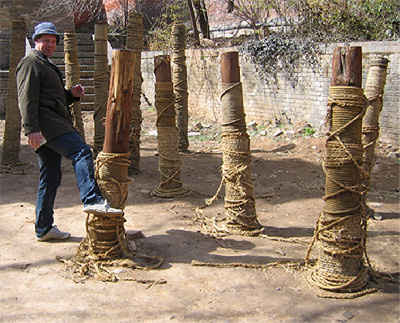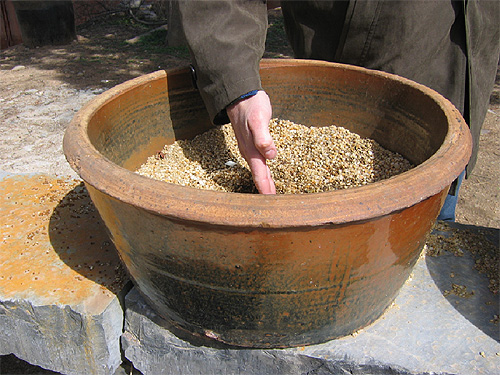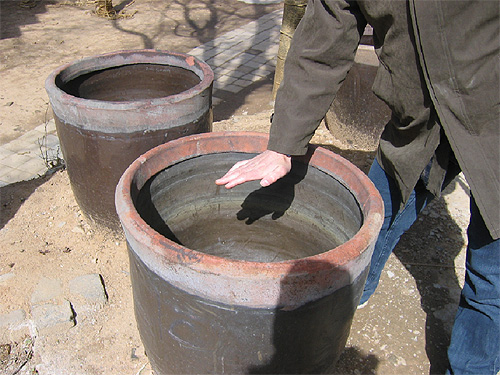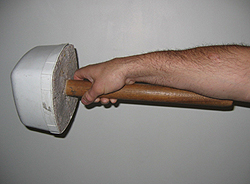Using the modern boxing bags and mitts is a start, but there are innumerable other exercises. Here are a few of the more traditional ones...
A beginner's bag can be made of thin double canvas or denim material that is approximately 25 x 25 centimetres in size and filled with mung beans, which are dense, small, and heavy. These green beans emit a mild anaesthetic when they begin to break down that works in conjunction with dit da jow liniment. Later an intermediate harder bag is filled with gravel, (or cat litter from a pet store). Then move onto the advanced �-inch ball bearings filled bag. These you want rust: the bearings being iron or steel; and not lead, stainless, or chromed steel. Over time and with use the rust that forms on these balls will get absorbed into the user�s hands, giving the skin a heavy, iron-like quality.
'Iron Palm' consists of striking the training bag four times with one hand, using different strikes. The same strikes are then repeated with the other hand. The body is held in a stable stance, most commonly a horse stance...
1. Palm: the hand is held with the fingers straightened and the thumb slightly bent and held close to the index finger. The palm of the hand should be slightly concave so that when contact with the bag is made there is a small space between the bag and the hand
2. Back of the hand
3. Side of the hand: similar to a karate chop on the little finger edge. As the hand is approaching the bag, the wrist joint is used to snap the side of the hand down onto the target
4. Tiger claw: for the sole purpose of conditioning the tips of the fingers and building the strength of the hand
Use the first two bags for three to six months each. Once advanced to the advanced bag, stay with that for the rest of the time training. When you start with a new bag, start training with short sessions of five to ten minutes gradually working up to 30 to 45 minutes a day. At the beginning of each practice session, warm-up first with a beginner, then an intermediate bag before going to the advanced bag.
After every training session rub dit da jow, a Chinese herbal solution used to toughen the skin and help dissipate any bruising, into the hands. The lotion is rubbed on the hands in a circular motion for about five minutes; then, rub the hand with a pushing motion toward the arm, (this is done to ensure the circulation of blood in the hand is moved back toward the heart).
If practised correctly, iron palm can become a very rewarding part of any kung fu training. It is very important that it be done correctly. If the timetable is rushed or if there is not enough time for any injuries to heal, then permanent damage may result. This is one of the hallmarks of good Iron Palm training--the hands are not disfigured at all.
These iron palm bags can also be used in other exercises. The size and weight of the bag can be increased to advance the exercise. At advanced training levels, when one has developed significant internal strength, the weight of the bag decreases. Eventually, the lighter bags become the bags for more advanced training...
1. Tossing and catching: standing in horse-stance, hold the bag to the side with one arm. Swing the bag skyward and release it on the up swing. The bag should go straight up and over the head. As the bag comes down, catch it with the other hand, keeping your arm straight (but not locked) and parallel with the ground. Continue this exercise while alternating sides
2. Tossing the bag behind the back: begin as before, holding the bag with one arm to the side: then, swing the bag behind the back and release it with a flick. The bag should go over the head, to the front of the body. Catch the bag with the opposite hand, just as in the first exercise.
In conjunction with these exercises, proper breathing techniques should be practised. During the up swing, one inhales. At the moment of the catch, one releases most of the breath with a short burst through the mouth.
It is important not to overestimate your ability and condition, or serious injury may result. The exercises on the board must be done in the correct way for genuinely benefit. The strikes on the board should be done slowly and purposefully. The mind focuses on the spot where you plan to strike. Then the blow is delivered, with full power. Penetration is the key. When you deliver the blow, think of penetrating the surface and applying pressure through it.

Tiger claw is practised on the board in two ways...
1. Palm and the tips of fingers straight on the board
2. Palm strikes the front of the board and the claw wraps around the board's side: strengthening the fingers
In practising on the bags, drill striking not only looking fully at the target, but also with the head turned slightly away training the peripheral vision as well.
The hands can be conditioned for this exercise by using a saltwater bath, consisting of half a cup of salt in three cups of water. Soak your hands for a minute. Do this before working in the beans and you�ll soon find you moving onto more resistant materials. This conditioning technique was suggested by the example of dock workers, whose hands, soaked in brine, could, take a great deal of abuse and not split the skin. This too can be used as an exercise, when the water is placed in a large container and then slapped with an open palm. Traditionally this was done during the winter, when layers of ice would form on the surface, having to be cracked like a board.
To condition palms and arms: pick up a handful of the ball bearings, and extend the arms in front of you, at chest level. Rub the ball bearings between your palms, as if you were polishing the metal with your hands.


This simple weightlifting device can be used another way: hold it in one hand, dowel extended before you, and do the rolls single-handed. This strengthens the wrist and forearm, as well as conditioning the hand�s grip.
Using a round weight, grip the weight firmly with both hands on the outside of the disc. Slowly rotate the disc, clockwise, and then counter clockwise. This is especially valuable in training the arms for the �Lions Teeth� application at the end of 'five animal form'.
For developing the tiger hand, utilising a light sphere, such as a baseball or softball, or even a grapefruit, then work up to a heavy shot put. Throw it into the air and catch it with one hand. Let it roll off the fingers and then catch it. This trains grip as well as reflex speed.
The phone books are also useful means to practice striking at home. Kneeling in front of the book, practice your backhand, the edge of your hand, the palm, the hammer blow, and the tiger claw tips against the book. Try a range of hand positions, such as the one and two-knuckle finger punches, as well as the four-knuckle panther strike.

In addition to using the heavy bag, you can practice strikes on the speedball. This trains accuracy and timing, as the ball moves so fast. Try the speedball looking away from it, to enhance your peripheral vision.
Push up exercises such as wide-arm, fingertip, three and two-finger as well as back and side of the wrist versions help to increase upper limb and finger strength.


No matter how well you think you know a technique, until you've done it 1000 times, it doesn't really become a part of you. Repetition is the secret of conditioning.